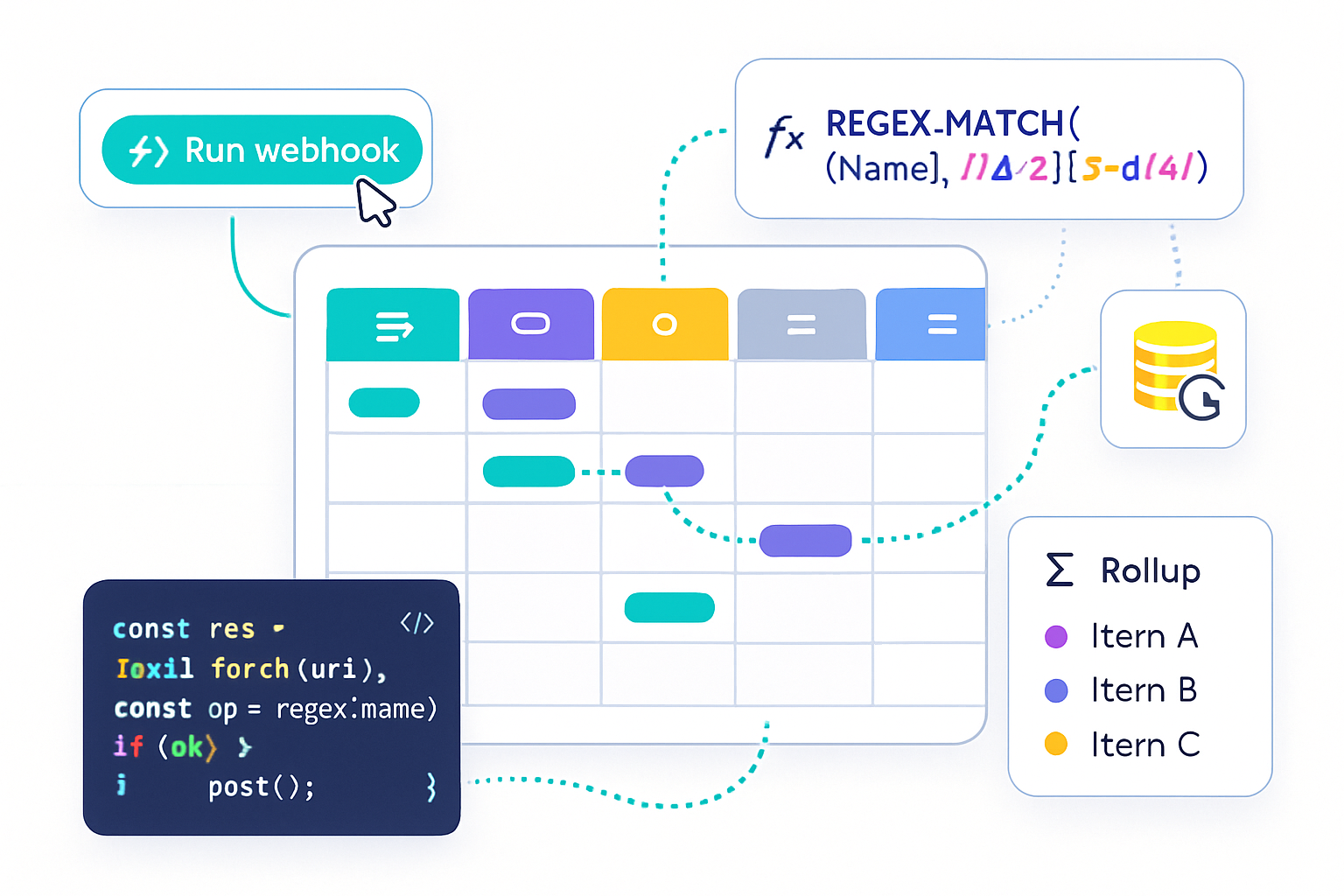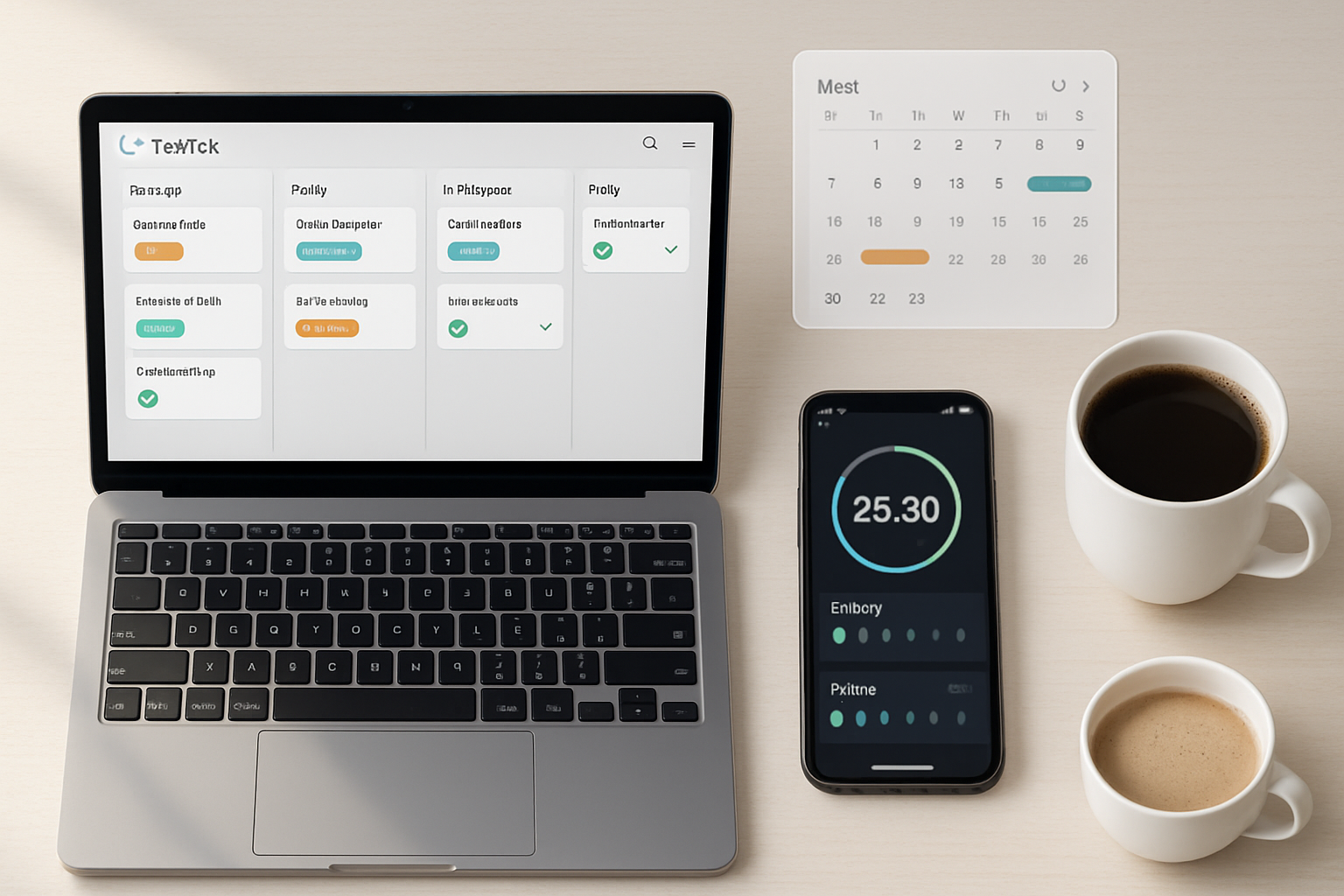· productivity · 6 min read
10 Hidden Airtable Features You Never Knew Existed
Discover 10 lesser-known Airtable features - from private views and record deep-links to webhooks, regex formulas, and snapshots - with practical examples and step‑by‑step tips to boost your workflows.

Why these hidden features matter
Airtable looks simple at first glance, but it hides a lot of power beneath the surface. These lesser-known features can save hours of manual work, make sharing more precise, and let you build small internal apps without leaving your base. Below are 10 features many users miss - plus practical examples and copy‑paste snippets so you can use them right away.
1) Personal (private) views - make views just for you
What it does: Create views that only you see. Great for experiments, personal filters, or custom dashboards without disturbing teammates.
How to use it:
- Open any view, click the view dropdown, and choose Create a view → select Grid / Gallery / etc.
- In the view menu, toggle Personal view (this keeps it hidden from other collaborators).
When to use it: Build a “My Tasks” view that filters by your collaborator field, or create a private testing view for formulas and automations before making them public.
Reference: See Airtable views overview for details: https://support.airtable.com/hc/en-us/articles/360056057274-How-to-create-and-organize-views
2) Deep link to records + prefill forms (RECORD_URL and form prefill)
What it does: Create links to specific records and prefill form fields via URL parameters.
Formula examples:
- Get a record link to open in Airtable:
RECORD_URL()- Prefill a form from a formula or button (URL example):
https://airtable.com/shrXXXXXXXXXXXX?prefill_FieldName=Example&prefill_OtherField=123How to use it:
- Use RECORD_URL() in a formula field to make a clickable link for reference or cross-tool navigation.
- Build a button that opens a prefilled form to let people quickly submit follow-ups with context already filled.
Use case: Send a link to a client or teammate that opens a form with the record ID and key fields prefilled so they can add comments or approvals.
Reference: Form prefill pattern: https://support.airtable.com/hc/en-us/articles/360043052213
3) Button field + Webhook trick - trigger automations from a click
What it does: The Button field can open a URL. Use that to hit an automation webhook (Airtable’s own webhook trigger or external endpoints like Zapier/Make) to trigger actions on demand.
How to set it up:
- Create an automation in Airtable with trigger When webhook received. Copy the webhook URL.
- Add a Button field to your table.
- Configure the button to Open URL and paste the webhook URL, optionally adding query params like
?recordId={RECORD_ID()}.
Button URL example with record id:
https://webhook.airtable.com/your-webhook-id?recordId={RECORD_ID()}Why it’s useful: Let people approve things, run a synchronization, or trigger a complex workflow with one click - without needing special permissions for the automation itself.
Reference: Webhooks and automations: https://support.airtable.com/hc/en-us/articles/360056441593-Using-webhooks-in-automations
4) Powerful text parsing with REGEX formulas
What it does: Use REGEX_MATCH(), REGEX_EXTRACT(), and REGEX_REPLACE() to extract codes, normalize inputs, or validate text formats inside formulas.
Examples:
- Extract invoice numbers like “INV-12345” from a notes field:
REGEX_EXTRACT({Notes}, "INV-(\\d+)")- Normalize phone numbers (strip non-digits):
REGEX_REPLACE({Phone}, "[^0-9]", "")When to use it: Clean incoming form data, pull order numbers from freeform text fields, or validate fields for automations.
Reference: Formula field guide: https://support.airtable.com/hc/en-us/articles/203255215-Formula-field-reference
5) Rollups with ARRAY functions - build smart summaries
What it does: Rollup fields aggregate values from linked records. Combine rollups with functions such as ARRAYJOIN(), ARRAYUNIQUE(), and ARRAYCOMPACT() to create readable summaries.
Examples:
- Join all linked task names into a single cell:
ARRAYJOIN(values, ", ")- Only unique values (remove duplicates):
ARRAYJOIN(ARRAYUNIQUE(values), ", ")- Remove blank values and join:
ARRAYJOIN(ARRAYCOMPACT(values), "; ")Use case: Show a comma-separated list of active owners, tags, or related milestone names on a parent record.
Reference: Rollup field documentation: https://support.airtable.com/hc/en-us/articles/360056619973-Rollup-field-reference
6) Scripting app - one script can replace dozens of clicks
What it does: Write short JavaScript to query tables, batch-update records, create or link records, and call external APIs.
Sample script (update a “Status” field for selected records):
let table = base.getTable('Tasks');
let query = await table.selectRecordsAsync();
let updates = [];
for (let record of query.records) {
if (
record.getCellValue('Due') &&
new Date(record.getCellValue('Due')).getTime() < Date.now()
) {
updates.push({ id: record.id, fields: { Status: 'Overdue' } });
}
}
while (updates.length) {
await table.updateRecordsAsync(updates.slice(0, 50));
updates = updates.slice(50);
}
output.text(`Updated ${updates.length} records`);Why it’s a hidden superpower: Scripts let you implement granular logic (deduping, bulk linking, conditional updates) without external tooling.
Reference: Scripting app docs and examples: https://support.airtable.com/hc/en-us/articles/360058190613-Introduction-to-scripting
7) Cell history - see who changed what (and restore it)
What it does: View the change history for a specific cell and restore previous values. This is invaluable when something breaks unexpectedly.
How to use it:
- Right-click (or click the caret) on a cell and choose Cell history (or History in some layouts).
- Review changes and restore an earlier value if needed.
When to use it: Troubleshoot a bad automation run, recover accidental deletes/edits, or audit changes to critical fields.
Reference: Restoring cell history: https://support.airtable.com/hc/en-us/articles/360049116794-Viewing-cell-history
8) Create true bi-directional links using Automations (auto-linking)
What it does: Airtable links are technically one-directional fields; you can simulate bi-directional relationships automatically by creating records and updating link fields via automations.
How to do it:
- Create an automation triggered When record created (in child table) or When record matches conditions.
- Use the Create record action to create the related record in the other table.
- Capture the new record’s ID and use an Update record action to add that ID into the original record’s link field (or vice versa).
Why it’s useful: Keep two tables synchronized without manual linking - great for migrating CSV imports, building mirrored task/issue trackers, or keeping external datasets connected.
Reference: Automations guide: https://support.airtable.com/hc/en-us/articles/360056350254-Automations-overview
9) Sync a table from a view - selective cross-base sharing
What it does: Sync lets you mirror a view from another base or workspace. Use a source view to control exactly which records and fields sync.
Best practices:
- Create a dedicated source view with filters and the exact fields you want to expose.
- Use the destination’s sync settings to decide whether linked fields are preserved as text, linked records, or editable fields (note - sync is primarily one-way).
When to use it: Share curated datasets across projects, keep a central reference table in sync, or expose only approved data to contractors.
Reference: Sync documentation: https://support.airtable.com/hc/en-us/articles/360056618533-Syncing-a-table-across-bases
10) Base snapshots - a real undo for big changes
What it does: Snapshots capture a full backup of a base at a point in time. You can preview or restore snapshots - invaluable before major restructures.
Where to find it: In a base, open the dropdown (top-left) → Snapshot & restore (or See revision history / snapshots depending on plan).
When to use it: Before renaming fields, deleting tables, running mass scripts or imports - create a snapshot so you can roll back if something goes wrong.
Reference: Snapshots and restoring: https://support.airtable.com/hc/en-us/articles/360058919254-See-and-restore-base-snapshots
Quick bonus tips
- Keyboard shortcuts - Press
- Use a small testing workspace or a personal view to iterate on complicated formulas before applying them to production.
- Combine features - button + script + automation = tiny apps inside Airtable.
Final thought
Airtable is deceptively deep - the real productivity gains come from combining a few of these hidden features. Start with one: try a personal view or a RECORD_URL button today, then add a script or webhook when you’re ready to automate more complex flows.
References
- Airtable formulas and function reference: https://support.airtable.com/hc/en-us/articles/203255215-Formula-field-reference
- Automations and webhooks: https://support.airtable.com/hc/en-us/articles/360056441593-Using-webhooks-in-automations
- Scripting app intro: https://support.airtable.com/hc/en-us/articles/360058190613-Introduction-to-scripting
- Syncing a table across bases: https://support.airtable.com/hc/en-us/articles/360056618533-Syncing-a-table-across-bases
- Snapshots and history: https://support.airtable.com/hc/en-us/articles/360058919254-See-and-restore-base-snapshots



